During a field trip to the Mishmi Hills, Arunachal Pradesh, India between October 24th and October 31th, 2017 a serow was observed. Comparing physical features of different species helped narrowing down it’s ID.
Introduction
The Mishmi Hills are situated at the junction of the Northeastern Himalaya and the Indo-Burma Ranges. The area is claimed by India and China. On the Indian side, the Mishmi Hills are located at the northeastern tip of the country, in central Arunachal Pradesh.
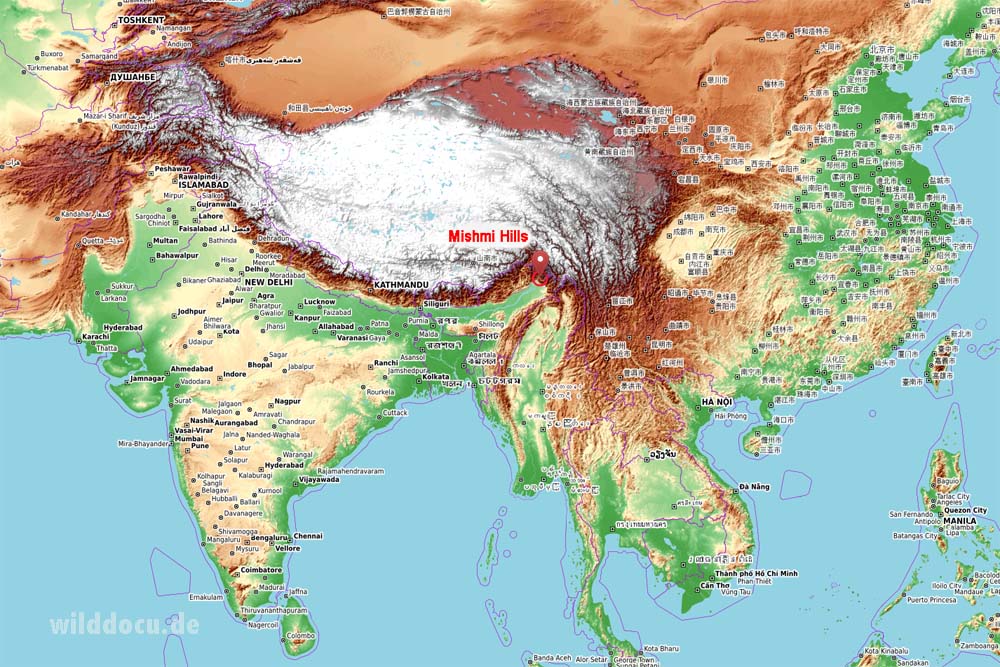

It appears that the ranges of Himalayan Serow (C. thar), Chinese Serow (C. milneedwardsii), Red Serow (C. rubidus) and of a yet unnamed reddish serow known as Assamese Red Serow, may meet or even overlap in the border regions between India (Arunachal Pradesh), western and northern Myanmar and China. The Mishmi Hills are located within this region. Therefore the distribution ranges of these phenotypes presented in the literature must still be seen as provisional and as very vague. [1] Hybrids are to be expected in such an area.
Accordingly any documented sighting of a serow from this intergrading area can help to narrow down the identity and distribution ranges boundaries of the respective specimen.
Methods
For the staying in the Mishmi Hills a car and driver was provided by Aborcountry – aborcountrytravels.com. In the Mishmi Hills driver Khanin Kalita and local guide Drama Mekola helped to manage logistical challenges. We routinely stopped the vehicle at viewpoints to scan open stretches with binoculars. At one of these occasions the serow was spotted crossing a scree field. The animal could only be observed for a few seconds – time enough to take a few photos with a 600 mm lens.
Raw-photos were developed and cropped and the physical features of the serow specimen analysed and compared with those of the four occurring phenotypes. Furthermore the coordinates were determined.
Results
The specimen was located at approximately 28.231601 northern latitude, 95.842986 eastern longitude.
Analysed images
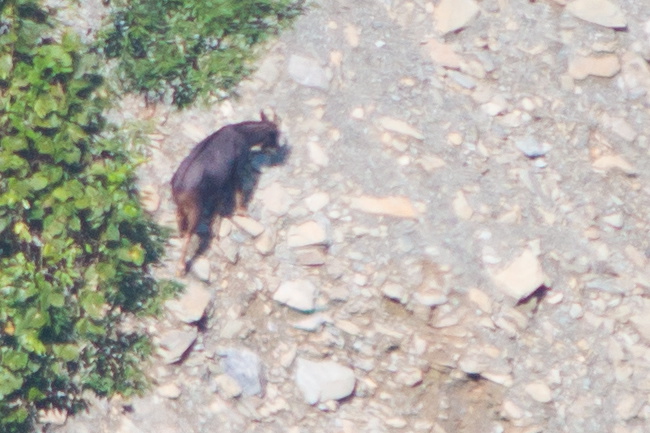

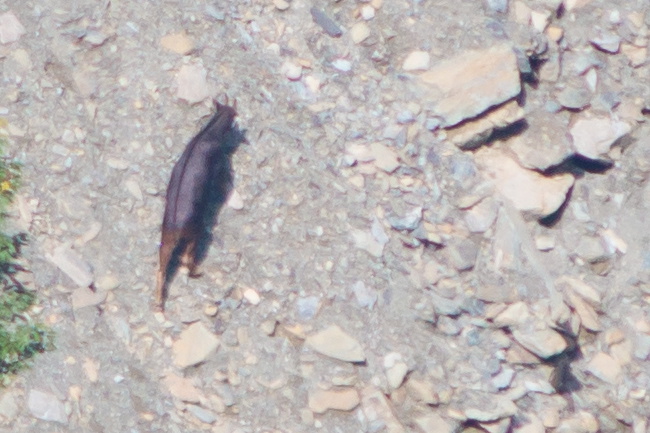
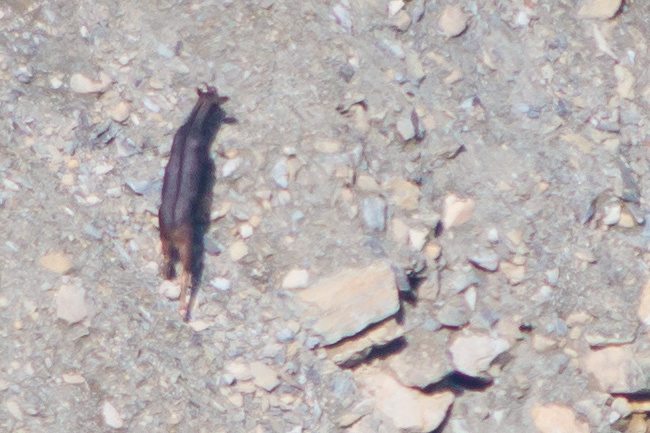

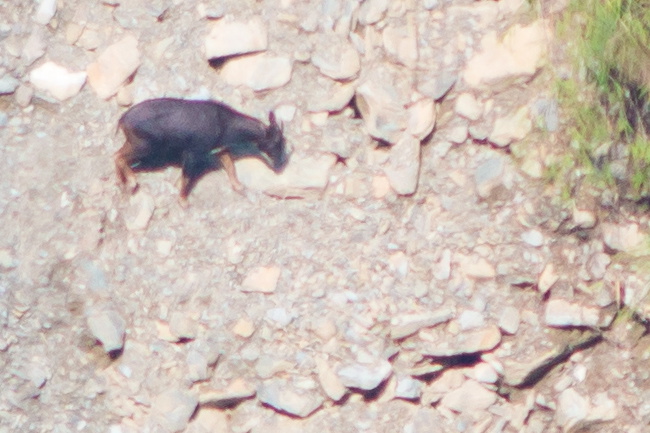
ID’ing the specimen: Because of the general darkish pelage colour Red Serow (C. rubidus) and reddish Assamese Red Serow could be excluded.
Table 1: Comparison of physical characteristics of Himalayan Serow, Chinese Serow and the serow specimen from Mishmi Hills
| Himalayan Serow (HS) | Chinese Serow (CS) | Mishmi Hills specimen | |
| pelage in general | dark black [3]; black tips of the hair becoming redder lower down the flanks. [4] | generally black, grading to reddish on flanks, rump and tail [4, 3] – but less than in HS | black; flanks barely reddish; more like CS |
| under- parts | sharply cream-buff [4], paler [3] | paler [3], light [4] | only white spot on sternum visible |
| dorsal stripe | sometimes visible, but not usually marked so [4] | present | clearly marked |
| mane | long, mixed black and white [3, 4], varying, but never with the white predominating [4] | typically thick [1], long, shaggy, mainly silvery [3, 4] | not present (young animal?) |
| tail | black [1]; specimens with mixed black, red and white hairs are known | bushy [3]; black a the tip; russet in middle third; blackish mixed with gray basally [1] | reddish; with black median line |
| limbs | black hair tips on the legs becoming red lower down; below „knees“: creamy white [4] | from the „knee“ down: rusty; extends on the hind legs upwards along the edge of the buttocks. [1] | inside of thoracic limbs: rusty; hardly any white on fetlocks; outside thoracic limbs above carpal joints: black; as in CS |
| head / face | sometimes lighter than body [4]; broadly white over nose, or only on lip margins; white extending along jaw lines or interramal region or nearly absent. [4] | browner than body [4, 3]; white markings: present, but no remarks found in the literature) | barely lighter than body; only interramal region: white |
| ears | light-coloured inside (only two specimens seen) | lined inside with long white hairs [1] | outside: reddish; insight: not visible |
Discussion
The specimen observed is not clearly relatable. But some characteristics indicate a relation to the Chinese Serow: The flanks are less reddish, like those of Chinese Serow. The outer side of the right thoracic limb above the carpal joints is black. This is also a feature that is more commonly sighted in Chinese Serow, but not so in Himalayan Serow.
A white mane is not present in the Mishmi Hill specimen (which is said to be typical for the Chinese Serow), in fact there is no mane at all. However Dolan (1963) states that mane colour (length too?) is also a function of age: older animals tending to have more white in the mane. [4]
However Hrabina (pers. comm.) is convinced that the specimen has „typical features of the Himalayan Serow (Capricornis thar)„, i.g. the white rim around the hooves on pelvic limbs. [6]
Conclusion: A presumably rather uncommon serow phenotype has been described. More investigations are needed to outline the scale of physical feature variability in serow species.
Literature / sources
[1] Damm, Gerhard R. and Franco, Nicolás, 2014: The CIC Caprinae Atlas of the World – CIC International Council for Game and Wildlife Conservation, Budakeszi, Hungary in cooperation with Rowland Ward Publications RSA (Pty) Ltd., Johannesburg, South Africa.
[2] Duckworth, J.W. & MacKinnon, J. 2008. Capricornis thar. The IUCN Red List of Threatened Species 2008: e.T3816A10096556. http://dx.doi.org/10.2305/IUCN.UK.2008.RLTS.T3816A10096556.en. Downloaded on 03 May 2017.
[3] Wilson, D.E. and Mittermeier, R.A. [eds], 2011: Handbook of the Mammals of the World. Vol. 2. Hoofed Mammals. Lynx Edicions, Barcelona.
[4] Groves, Colin and Grubb, Peter, 2011: Ungulate Taxonomy. The John Hopkins University Press.
[5] Castelló, José R., 2016: Bovids of the World – Antelopes, Gazelles, Cattle, Goats, Sheep, and Relatives. Princton University Press.
[6] Hrabina, Petr: Museum of Southeast Moravia in Zlín, Vavrečkova 7040, 760 01 Zlín. Department of Zoology, Fisheries, Hydrobiology and Apiculture, Mendel Univerzity in Brno, Zemědělská 1, 613 00 Brno

